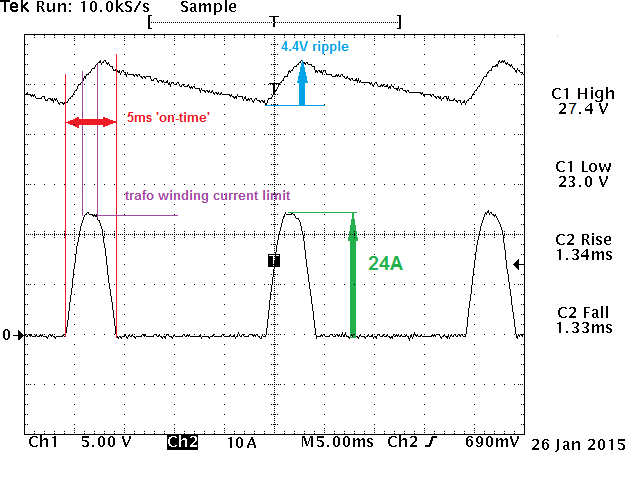There are a few things at play here.
The most important thing here is that aside from voltage drop and flattening of the AC voltage we must realize the
power is not coming from the voltage but from the drawn
current.
ALL audio equipment use rectifiers which only do 'something' near the voltage peaks (positive and negative) and
conduct only shortly.
In that small time period the
voltage across reservoir caps
need to be replenished by
these currents.
This means there has to be a wide enough bandwidth (well over 50/60 Hz) to be able to handle the fast current transient.
Below current in the secondary windings (and thus similar shaped but different in value on the primary side) of a transformer.
The upper trace shows the voltage (ripple) across the reservoir caps being replenished and then discharged by the load (the absolute voltage levels are given next to the trace.
Lower trace shows the current in the transformer. Note that the circuit used draws a constant 3.3A (82W) yet the current from the transformer is 24A (peak) because of the short time it has to replenish. The current (24A peak) in this case is limited by the transformer itself.
Below the spectrum of these currents:
What we see here is that up to around 500Hz we don't want any filtering otherwise the current can't rise fast enough.
Filtering of mains below. The big inductors do this, the small common mode ones are starting to do something well above the audible range.
500Hz... check. Optimal filtering for audio equipment. So well done Puritan Audio. This is far lower than most other conditioners.
DC-blocking ... check.. can be handy when certain equipment in the room sometimes hums audible and at other times doesn't.
Nice to have in there all the time.
Followed by individual
common mode chokes followed by glass fuses
per output. Switching noises coming from connected gear (usually high in frequency) thus are filtered twice between each connected device.
However, only for HF noise.
Audio frequency
common mode ground loop currents are not attenuated so when there are several devices with different ground loop currents and SE (RCA) connectors are used these pesky common mode currents that induce small voltages across the shielding of RCA cables thus still can induce small voltages.
Depending on the shield resistance (cable quality) and ground loop currents these can reach audible levels.
So no... it won't fix all gremlins.
The problems some folks talk about and blame on not so clean mains that become audible to them means they are either using audio equipment with poor PSRR (sensitive to power supply fluctuations) or have ground loop issues they are not aware off.
Those pesky 'spikes' they hear caused by heavy machinery are most often common mode. If they were differential mode (between L and N) then many devices that have MOV's or other peak voltage limiters may have equipment fail pretty often.
To those people I would advise to check each device separately, look for gear that is connected using balanced cables or use a regenerative UPS.
When troubled with ticks and noises... first get the equipment and interlinks sorted out (not easy to do) and only then start with power supply conditioning.
One can only gain so much starting out with mains filtering.
See mains filtering as a last resort instead of a starting point for improving a flawed audio system.
The claims of 'always improving' audio quality is what Amir measures here. In that sense it is limited in what is measured.
One as to realize that there is not one single EMC test that can show what happens in anyone's home and audio system where the usual values that are used for testing are exceeded. This likely is the case here and there.
So folks... stop bitching about how Amir does not show your or anyone else's particular conditions.
Just realize what is measured here is the (always false) claim conditioners ensure 'audible improvements' and NOT immunity to common mode crap which differs in EACH condition in each home.


